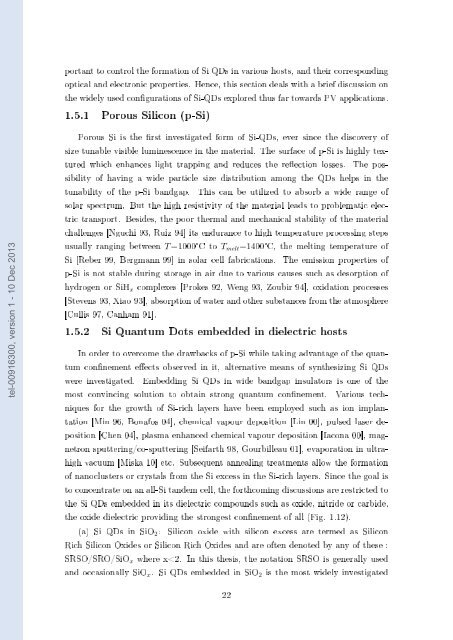Films minces à base de Si nanostructuré pour des cellules ...
Films minces à base de Si nanostructuré pour des cellules ...
Films minces à base de Si nanostructuré pour des cellules ...
You also want an ePaper? Increase the reach of your titles
YUMPU automatically turns print PDFs into web optimized ePapers that Google loves.
portant to control the formation of <strong>Si</strong> QDs in various hosts, and their corresponding<br />
optical and electronic properties. Hence, this section <strong>de</strong>als with a brief discussion on<br />
the wi<strong>de</strong>ly used congurations of <strong>Si</strong>-QDs explored thus far towards PV applications.<br />
1.5.1 Porous <strong>Si</strong>licon (p-<strong>Si</strong>)<br />
tel-00916300, version 1 - 10 Dec 2013<br />
Porous <strong>Si</strong> is the rst investigated form of <strong>Si</strong>-QDs, ever since the discovery of<br />
size tunable visible luminescence in the material. The surface of p-<strong>Si</strong> is highly textured<br />
which enhances light trapping and reduces the reection losses. The possibility<br />
of having a wi<strong>de</strong> particle size distribution among the QDs helps in the<br />
tunability of the p-<strong>Si</strong> bandgap. This can be utilized to absorb a wi<strong>de</strong> range of<br />
solar spectrum. But the high resistivity of the material leads to problematic electric<br />
transport. Besi<strong>de</strong>s, the poor thermal and mechanical stability of the material<br />
challenges [Nguchi 93, Ruiz 94] its endurance to high temperature processing steps<br />
usually ranging between T=1000°C to T melt =1400°C, the melting temperature of<br />
<strong>Si</strong> [Reber 99, Bergmann 99] in solar cell fabrications. The emission properties of<br />
p-<strong>Si</strong> is not stable during storage in air due to various causes such as <strong>de</strong>sorption of<br />
hydrogen or <strong>Si</strong>H x complexes [Prokes 92, Weng 93, Zoubir 94], oxidation processes<br />
[Stevens 93, Xiao 93], absorption of water and other substances from the atmosphere<br />
[Cullis 97, Canham 91].<br />
1.5.2 <strong>Si</strong> Quantum Dots embed<strong>de</strong>d in dielectric hosts<br />
In or<strong>de</strong>r to overcome the drawbacks of p-<strong>Si</strong> while taking advantage of the quantum<br />
connement eects observed in it, alternative means of synthesizing <strong>Si</strong> QDs<br />
were investigated. Embedding <strong>Si</strong> QDs in wi<strong>de</strong> bandgap insulators is one of the<br />
most convincing solution to obtain strong quantum connement. Various techniques<br />
for the growth of <strong>Si</strong>-rich layers have been employed such as ion implantation<br />
[Min 96, Bonafos 04], chemical va<strong>pour</strong> <strong>de</strong>position [Lin 00], pulsed laser <strong>de</strong>position<br />
[Chen 04], plasma enhanced chemical va<strong>pour</strong> <strong>de</strong>position [Iacona 00], magnetron<br />
sputtering/co-sputtering [Seifarth 98, Gourbilleau 01], evaporation in ultrahigh<br />
vacuum [Miska 10] etc. Subsequent annealing treatments allow the formation<br />
of nanoclusters or crystals from the <strong>Si</strong> excess in the <strong>Si</strong>-rich layers. <strong>Si</strong>nce the goal is<br />
to concentrate on an all-<strong>Si</strong> tan<strong>de</strong>m cell, the forthcoming discussions are restricted to<br />
the <strong>Si</strong> QDs embed<strong>de</strong>d in its dielectric compounds such as oxi<strong>de</strong>, nitri<strong>de</strong> or carbi<strong>de</strong>,<br />
the oxi<strong>de</strong> dielectric providing the strongest connement of all (Fig. 1.12).<br />
(a) <strong>Si</strong> QDs in <strong>Si</strong>O 2 : <strong>Si</strong>licon oxi<strong>de</strong> with silicon excess are termed as <strong>Si</strong>licon<br />
Rich <strong>Si</strong>licon Oxi<strong>de</strong>s or <strong>Si</strong>licon Rich Oxi<strong>de</strong>s and are often <strong>de</strong>noted by any of these :<br />
SRSO/SRO/<strong>Si</strong>O x where x
















